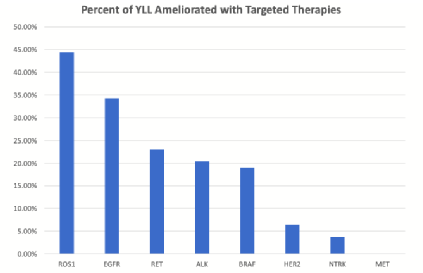EGFR, MET, ROS1, HER2 and other targeted therapy, how much time did it save for patients with lung cancer?
Author:Cancer Channel of the Medical Time:2022.06.16
*For medical professionals for reading reference

The latest research results of check -in ~
Lung cancer is one of the greatest malignant tumors in the world's health and life threats in the world, and it is also the main cause of the mortality of cancer -related diseases worldwide [1]. Among them, non -small cell lung cancer (NSCLC) accounts for about 85 % of lung cancer -related death [2]. In recent years, with the discovery of various driving mutations such as EGFR, ALK, MET, NTRK, targeted therapy for related targets has also continued to develop. Improved [3].
Studies have shown that driving mutations are correlated with the age of patients during the diagnosis of cancer. Patients with younger lung cancer are more likely to carry targeted genotype [4]. So, does targeted therapy bring the benefits of some patients with a targeted mutation, can the benefits of patients with a targeted mutation be made up for the time of the loss of NSCLC patients who are older than those who are older and have no targeted mutation?
Some research team calculates that there is/no in the median age of the expected life, diagnosis of NSCLC, the mid -level relief duration (DOR) or median total survival (OS) of different targeted therapies. The differences between the median diagnosis of patients with targeted mutations, as well as their expected life expectancy and the difference in actual age due to NSCLC's death, is the year of life (YLL). Treatment may improve the life of patients. The relevant evaluation data of this part is published in Cancer Medicine [5].
The improvement of survival brought by targeted therapy still cannot make up for the loss of life caused by the youthfulness
The test used the retrospective cross -section research, which evaluated the approval of the U.S. Food and Drug Administration (FDA) as of March 3, 2021 and was recommended in the US National Comprehensive Cancer Network (NCCN) NSCLC Guide for treatment of NSCLC's NSCLC All targeting therapies and chemotherapy and immunotherapy schemes.
Researchers further retrieve the results of the clinical trials of each treatment plan through PUBMED, extract the median DOR/medium OS, the median diagnostic age of the patient, and use the total life expectancy of the United States as the average expected life. Calculate and calculate separately, respectively Compared with the cumulative estimation of the survival time of NSCLC patients with/unable to targeted mutations, the percentage percentage (%) of the difference in the improvement of YLL after the improvement of targeted therapy, etc.
The results of the study show that regardless of the PD-L1 status, the median diagnosis age of NSCLC patients who are unable to target mutations is 71 years old, the median Dor is 1.2 years, and the cumulative estimation of 72.2 years of survival (median diagnosis age+median Dor DOR To.
In contrast, patients with NTRK, ALK, HER2, ROS1, RET, Braf, EGFR, and MET mutations are 47.6, 52.0 years old, 62.0 years old, 57.0 years old, 63.0 years, 69.0 years old. And 72.0 years old, among which DOR is 0.9, 3.9 years, 0.6 years, 6.2 years, 2.2 years, 1.5 years, 3.1 years, and 2.4 years. The year, 63.6 years, 64.5 years, 72.1 years, and 74.4 years.

Figure 2 Cumulative estimation of/unable to targeted mutations in NSCLC patients
In addition, patients with targeted mutations are often diagnosed earlier than patients without targeted mutations. In this experiment, patients with NTRK, ALK, ROS1, EGFR, RET, HER2, and BRAF mutations are less targeted. , 9 and 8 years.
Based on this, the researchers calculated the percentage of the difference between life loss (YLL) due to different mutation types for different mutation types, that is, the number of years of medium DOR/early diagnosis × 100%. Taking EGFR as an example, the bit DOR is 3.775 years. Compared with non -driven gene mutations, patients have been diagnosed for 11 years. Therefore, the YYL difference percentage improved by targeted therapy is 34.3%(3.775/11 × 100%).
Specifically, ROS1, EGFR, RET, ALK, BRAF, HER2, and NTRK mutations received the YYL differences improved by targeted therapy was 44.3%, 34.3%, 22.9%, 20.5%, 18.8%, 6.4%, and 3.7. %. In other words, although targeted therapy has made great progress, NSCLC patients who drive gene mutations are still very severe due to the YYL burden caused by early death.

Figure 3 The difference rate of YLL after the targeted therapy of each mutation
With targeting the treatment indications, sometimes it is not a real "luck"
In recent years, the emergence of targeted therapy that can targeted mutations has brought an important impact on the formulation of advanced metastatic NSCLC treatment strategies, extracting these relevant data after targeted treatment with targeted mutations and statistics With analysis, it is necessary to evaluate the progress of targeted therapy. This test is the first study to be evaluated to accept the accumulated survival time and improved YLL difference rate for the advanced NSCLC patients for various mutations targeted therapy. Studies have found that the maximum median Dor patient is only 6.2 years (ROS1), and in the most ideal case, less than half (44.3%) of patients with ROS1 gene mutations can be made up Essence Therefore, although targeted therapy has made considerable progress, patients with targeted mutations still have a considerable number of YLL.
Of course, this observation research still has certain limitations, and the clinical trial data used did not take into account the number of conditions and influence of many real worlds. In terms of analysis results, the benefits of each targeted therapy are overall. However, in the most optimistic case, although targeted therapy paved the way for many young NSCLC patients with targeted mutations, compared with those who have not targeted mutations, they still bear more Large YLL burden.
Therefore, this study reminds us that we need to look at NSCLC patients with targeted mutations more comprehensively, and we must not only use "lucky" labels for patients because they can be approved for targeted therapy. Because although these targeted therapy can better extend their lives compared to traditional chemotherapy, YLLs of young NSCLC patients cannot be made up by this part of the benefit. The YLL accumulated worldwide by these patients will have a long or short -level effect on their own families, groups and society. Although the advanced NSCLC targeted therapy has made considerable progress, we may still have a longer way to reduce the burden of young patient YLL and make up for YLL.
references:
[1] Bray F, Ferlay J, Soerjomataram I, Siegel RL, Torre LA, Jemal A. Global cancer statistics 2018: GLOBOCAN estimates of incidence and mortality worldwide for 36 cancers in 185 countries [J].CA Cancer J Clin. 2018; 68 (6): 394-424.
[2] ZAPPA C, Mousa Sa. Non-Small Cell LUNG CANCER: Current Treatment and Future Advances.transl LUNG CANCER Res. 2016; 5 (3): 288-300.
[3] Herbst RS, MORGENSZTERN D, Boshoff C. The Biology and Management of Non-Small Cell LUNG CANCER.NATUR.Nature. 2018; 553 (7689): 446-454.
[4] Sacher AG, Dahlberg SE, Heng J, Mach S, Jänne PA, Oxnard GR. Association Between Younger Age and Targetable Genomic Alterations and Prognosis in Non-Small-Cell Lung Cancer.JAMA Oncol. 2016;2(3): 313-320.
[5] Benjamin DJ, Haslam A, Gill J, PRASAD V. Targeted Therapy in LUNG CANCER: Are We Closing The Gap in Years of Life Lost? [J] .cancer Med. 2022 Mar 22; 10.1002/CAM4703.
*This article is only used to provide scientific information to medical people, and does not represent the viewpoint of this platform


- END -
Can I really repair the bad credit records?The authoritative response of the People's Bank of C

Editor's note: June 14, 2022 is the 15th Credit Care Day in the country. As everyo...
The second wave of Chengdu Digital RMB online consumer coupons will open tomorrow!

The offline consumer coupon (first stage) issued by Yunli Pay has just come to an ...